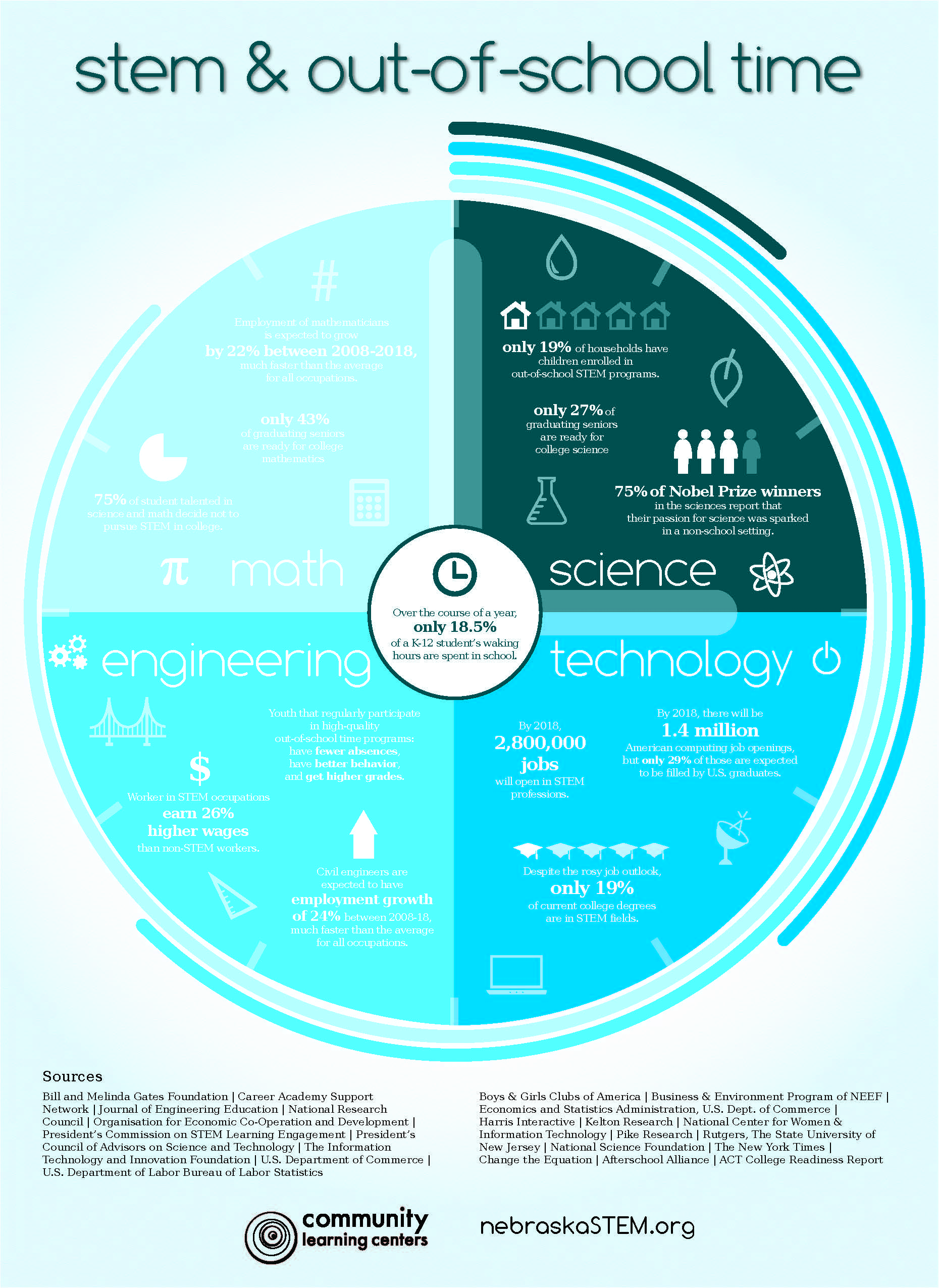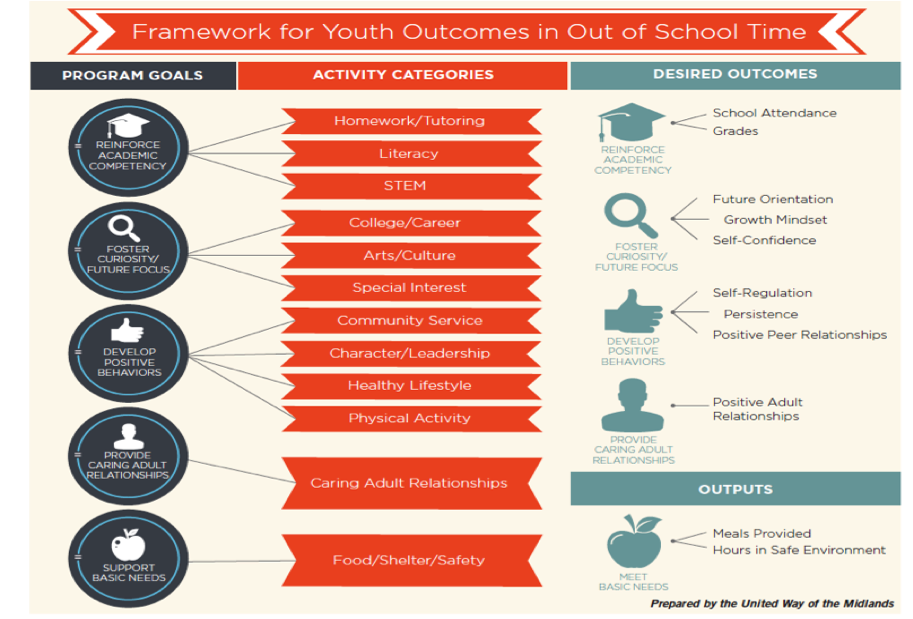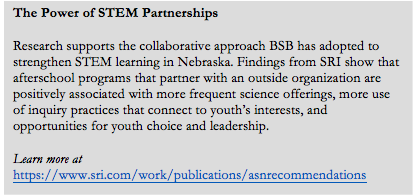Education in Nebraska is, first and foremost, a community-based endeavor. As befits our largely rural Great Plains state, this emphasis on local control—as opposed to centralized, top-down management—defines our approach to building the systems of support that help to ensure that young people in urban and rural Nebraska alike have access to the learning opportunities they need to thrive in the 21st century. Within this context, education in the STEM fields (science, technology, engineering, and math) has emerged as a key area of focus and investment in communities across the state.
In particular, expanded learning opportunities (ELO)—which, in Nebraska, means high-quality, school-based, and community-powered afterschool and summer programs—have been essential to advancing STEM learning statewide. This article tells the story of how the ELO sector in Nebraska has become a key platform for increasing the number and quality of STEM learning opportunities in our state by cultivating local partnerships, coordinating systems-building efforts across the state, and broadly communicating the importance of STEM learning for improved educational and economic outcomes.
Initial STEM Systems Building in Nebraska
Communities across Nebraska, rural and urban, are faced with an array of challenges related to our state’s lagging economy. Systemic budget constraints and the continued outmigration of our young people, especially those from rural communities, have given Nebraskans reason to consider what we need to do to support a diverse array of industries and businesses that will drive economic growth across the state. A constellation of education, industry, and community development advocates have come to realize that, for our economy to grow, it is paramount that we retain youth in our state and provide them with the educational opportunities, in STEM and other 21st-century workforce skills building, that they need for success.
Beyond School Bells (BSB), Nebraska’s statewide afterschool network, has played a leading role in establishing ELO as a primary engine for expanding STEM learning in the state. In 2011, thanks to an initial two-year grant (which was later extended for an additional two years) from the Robert Noyce Foundation, BSB began to explore strategies for building statewide ELO STEM systems.
Importantly, BSB’s community-based systems-building work coincided with the Nebraska Department of Education’s 21st Century Community Learning Centers program implementation of BLAST! (Building Lasting Afterschool STEM Teams), a NASA Summer of Innovation-supported STEM initiative that focused on building STEM partnerships with key statewide organizations, such as Nebraska Extension and the other University of Nebraska-based resources.
BSB’s early systems-building work focused on identifying resources and partnership opportunities for local ELO systems to connect with state-level STEM organizations and resources. BSB also began supporting community-driven ELO STEM efforts intended to encourage collaboration among local ELO programs and STEM professionals and organizations. These efforts represented the first initiative in the state focused on making afterschool and summer learning a central component of efforts to support STEM education statewide.
During this early phase, BSB focused intently on communicating the importance of ELO STEM in order to seed the conversation in communities across the state. BSB organized outreach events, such as ELO STEM Days at the State Capitol, STEM awareness events at the Nebraska State Fair, and an hour-long original program on ELO STEM on Nebraska Educational Television that was part of the State of Education in Nebraska series. BSB has also created numerous resources that make the case for ELO STEM. These outreach and communications activities helped raise the profile of ELO STEM with policymakers, funders, advocates, practitioners, and other key stakeholders. They also helped to build a strong foundation for later systems-building work.

In addition to a focus on communications and STEM outreach, BSB also emphasized (and continues to emphasize) capacity building for community-based ELO programs. Because ELO staff are not always well prepared to facilitate STEM learning activities, BSB has partnered with NE Extension, a division of the University of Nebraska, to implement a statewide training program to introduce ELO staff to the Click2SciencePD platform, a unique on-line tool that provides ELO staff with the support they need to effectively implement high-quality STEM activities in their programs. BSB also facilitated professional development efforts to train program staff in the use of the Dimensions of Success (DoS) site observation tool—created by the Program in Education, Afterschool & Resiliency at Harvard University (The PEAR Institute)—to measure the quality of ELO STEM learning opportunities and identify areas for improvement.
Leveraging Local Partnerships and Intermediaries to Build STEM Systems
Partnerships have played a critical role in the growth of ELO STEM in Nebraska, and this particularly evident in Nebraska’s largest city, Omaha. The city is home to well-established citywide ELO systems that have the capacity to provide leadership for the ELO sector statewide. BSB—in collaboration with Collective for Youth, Omaha’s ELO intermediary organization—took advantage of the infrastructure already in place in Omaha to expand on its initial systems-building work and develop and strengthen partnerships committed to improving youth outcomes (see Figure 2), a process in which STEM learning has a prominent role.

One such partnership connected Collective for Youth with STEM 4U, an initiative out of the University of Nebraska-Omaha that recruits and trains college students to provide hands-on, engaging STEM learning experiences to youth in ELO programs across Omaha. In addition to facilitating and strengthening local partnerships, the collaboration between BSB and Collective for Youth helped to map available STEM resources in the community and promote ELO STEM program quality through a combination of professional development support and program evaluation. This support was especially important for ELO programs and staff in the process of implementing STEM programming for the first time.
As the work of this collaboration has progressed, additional community-based partnerships have expanded access to high-quality STEM learning opportunities. In 2015, Omaha became one of the first Imagine Science communities. An ELO initiative that seeks to provide underserved youth with STEM programming at community-based sites, Imagine Science is facilitated through local-national partnerships among the four largest youth serving organizations: Boys & Girls Clubs of America, Girls Inc., the National 4-H Council, and the YMCA of the USA. In Omaha, these include the YMCA of Greater Omaha, Girls Inc. of Omaha, UNL Extension 4-H, and Boys & Girls Club of the Midlands.

Additionally, cross-sector partnerships in Omaha have led to the creation of the Omaha STEM Ecosystem. This collaborative effort involves stakeholders from throughout the educational continuum, including local school districts, businesses, science advocacy groups, and ELO organizations. In particular, two local institutions—the University of Nebraska at Omaha and the Henry Doorly Zoo and Aquarium—have led Ecosystem work to strengthen STEM-rich educational and career pathways. A member of the national STEM Learning Ecosystem Initiative, supported by the STEM Funders Network, the Omaha STEM Ecosystem initiative’s objectives are to:
- Build citywide collaborative capacity through consistent and diverse stakeholder engagement,
- Implement a shared framework that evaluates measureable effects of high-quality STEM programs,
- Provide professional development for STEM educators, and
- Implement a system that ensures students are engaged in high-quality STEM programs that build career-ready skills.
Encouraged by its successes in Omaha, BSB expanded its systems-building work to strengthen ELO STEM in rural communities across Nebraska. In this effort, BSB has focused on sustainability, using targeted mini-grants for established ELO programs to develop and reinforce local STEM partnerships. This strategy has resulted in a host of innovative partnerships, including regional collaborations with the Nebraska Game and Parks Commission and local nature centers that focus on outdoor education. Additionally, the strategy has established partnerships between local ELO organizations and Nebraska Extension to expand gardening, robotics, and other programs.
As part of this engagement strategy, BSB is focused on cultivating private sector partners to support expanded STEM career exploration for students in rural communities. BSB is also working with several communities to field test a new Career Exploration curriculum that is based on Nebraska Career Education standards and adaptable to local needs and community-based opportunities.
Capacity building also plays a major role in BSB’s rural ELO STEM systems-building efforts. In addition to professional development and program evaluation trainings—again through the use of Click2SciencePD and the DoS quality observation instrument—BSB is piloting a mobile makerspace—the TMC (Think Make Create) Lab—that provides rural ELO partners with fully-equipped maker trailers. These trailers not only facilitate STEM learning in a variety of community settings but also provide a platform for initiating partnerships that can sustain local programming.
Building on these efforts, BSB and a coalition of state organizations and local partners have established a goal of developing new ELO STEM learning opportunities as part of a broader collective impact model that links formal and informal learning environments to support student growth. Developing and sustaining the next generation of high-quality ELO STEM programs—and expanding access to ELO STEM in rural communities, which are often STEM and ELO “deserts”—represents the next challenge in Nebraska’s systems-building work.
Developing Policies to Support STEM
Nebraska’s strongly held commitment to local control manifests in the skepticism with which education stakeholders in our state often regard policy initiatives and mandates that emanate from Washington. The state was reluctant to accept No Child Left Behind and the accompanying system of standardized testing. The more recent Race to the Top initiative never gained traction as Nebraska communities remained committed to maintaining quality public school systems rather than join the booming charter movement. However, the state’s inclination toward education policies that are community-based does not mean it does not embrace the value of state- and national-level resources. In fact, it is quite the opposite; our systems-building approach may start from the ground up, but it is predicated on the idea that locally driven initiatives can and should leverage the resources and advantages that broader systems can provide.
Nebraska policymakers are acutely aware of our changing economy, and they increasingly recognize that the capacity of ELO programs to enhance STEM education. As a result, they are committing greater support to nascent statewide STEM systems-building efforts. Expanding on a 2013 Nebraska Board of Education-approved policy statement supporting high-quality afterschool and summer learning experiences, Nebraska legislators recently passed legislation that, for the first time in our state’s history, provides funding to support ELO innovations. Although this legislation is not exclusively focused on STEM, many of the ELO innovations that received support are STEM-oriented. Both the state Board of Education policy statement and this new legislation reflect a growing awareness in Nebraska of the importance of school-based and community-powered ELO activities. Moreover, they set the stage for future policies designed specifically to support out-of-school STEM.
As state policymakers continue to embrace the opportunities that ELO programs have to support the development of a more comprehensive education-to-workforce pipeline, current discussions center on opportunities to utilize ELO programs as platforms to expose youth to the career opportunities that are available in their communities and can be achieved through the following:
- Public-private partnerships to leverage resources. As ELO STEM policies are developed, they should build around strong philanthropic sector support and nonprofit organizations that want to support academic excellence, youth development, and economic vitality.
- Dedicated state funding stream for ELO programs. Dedicated funding is needed that aids in sustaining existing ELO programs; spawns new programs in ELO deserts; supports ELO innovations, including STEM initiatives; and that can be used to leverage private and community partnerships.
- Active involvement of business and industry. Nebraska policymakers recognize that ELO programs can provide an ideal platform to engage business and industry expertise in education, provide youth with opportunities to learn about careers available in their communities, and help students gain the 21st-century skills that are so important to workplace success. Future policies should take advantage of this platform and be structured in a way that provides flexibility to adapt to local conditions.
For ELO STEM to be successful and sustainable in Nebraska, programming should be based on local resources and strengths rather than relying on national models developed in other contexts. This is the Nebraska way—building systems of strong support for public schools, community-based ELO programs, and creating local STEM learning opportunities for a public that wants to contribute to the success of our young people.
Resources
Beyond School Bells—http://beyondschoolbells.org
Click2Science—http://www.click2sciencepd.org
Collective for Youth—http://www.collectiveforyouth.org
ELO STEM on Nebraska Educational Television—http://netnebraska.org/basic-page/learning-services/out-school-time-and-stem
Imagine Science—http://imaginesci.org/omaha/
STEM Ecosystems—http://stemecosystems.org
STEM Funders Network—http://stemecosystems.org/about-the-stem-funders-network/
21st CCLC BLAST—https://sites.google.com/a/education.ne.gov/nebraska-blast/home
Jeff Cole, Network Lead, Beyond School Bells
Julie Sigmon, Omaha STEM Ecosystem Director
Anna Wishart, Nebraska State Senator, District 27
Share

